by Tom Guerra.
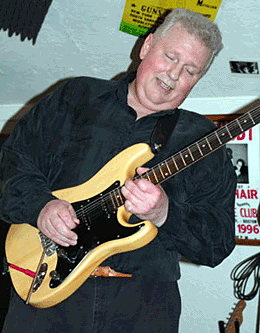 |
|
Mark Easton |
Guitarist Mark Easton has been a mainstay on the East Coast club circuit for more than three decades. A fiery rock and blues player and talented songwriter, Mark and Sweet Daddy Cool Breeze (one of his many bands), were just named Best Blues Band in the Northeast in a recent Advocate poll. Now in his early 50s, he’s playing at the top of his game and continues to stay busy both on the road and in the studio. Guitar International caught up with Mark in October, 2006, as he was preparing for another winter tour with Sweet Daddy Cool Breeze.
Mark’s discography dates back to 1975 when he first hit the studio with The Foster Brothers, a band that later evolved into the infamous Shaboo All-Stars. His next studio work, in 1979 with the regional sensation Avalanche, spawned a hit single “Little Miss Sad Eyes/ I’m Gonna Give My Love”. This single was also featured on radio station WHCN’s Homespun album, a late ‘70s sampler of New England talent. In the 1980s, Mark played on several studio sessions, including the hit disco single “General Hospital.” Of this recording, for which Mark was never credited, he admits receiving “the first of many lessons learned the hard way.” In the ’90s, Mark emerged stronger than ever with blues artists King Cod and the Blues Sharks, producing and co-writing their debut CD Gimme Clean Water before hooking up with harpist/vocalist Wally Greaney’s world touring group, Sweet Daddy Cool Breeze.
Over the past 13 years, Sweet Daddy has since recorded several excellent studio and live CDs, including Don’t Pass Me By, the excellent live Blowin’ Down The House and 2004’s Back for More. Mark has also been busy recording with his own group, The Easton Brothers Band, releasing Wait For The Medicine Man (1994) and Highway Hallucinations Part 2 in 2000.
On the day we spoke, Easton was preparing for Sweet Daddy’s tour of the Southeast United States, which kicks off February 16, 2007, in Amelia Island, Florida.
First off, I’d like to congratulate you on winning the Best Blues Band competition. How about telling us a bit about the projects in which you are currently involved?
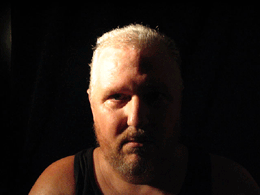 |
|
Mark Easton |
Mark Easton: Hi, Tom. I am recording and doing a few gigs with the Easton Brothers Band, with my brother, Barry on drums, and Walter Albert on bass. Barry and I also recently began recording again with Micheal Foster and bassist Michael Corsini (“Eight to the Bar”) in the late, great Charles Calmese’s spot in Avalanche. I have also been touring and recording with internationally known Blues artists Sweet Daddy Cool Breeze, as well as running Roughcut Studio with my brother. I also do many gigs as a hired gun with other artists, including a few gigs coming up with Jaimoe [Allman Brothers drummer] and jazz bassist Joe Fonda.
You are recognized today as one of the top guitarists in New England. What is your take on the state of live music these days?
ME: It’s always been a rough business, and things have not been heading in a good direction. The advent of computer-based music is a two edged sword. On one hand, it’s allowed many musicians who don’t have record contracts or financial backing to record and distribute their music, either at gigs or using the Internet. At the same time, it’s allowed a plethora of people with little or no actual musical talent to manipulate sound into cohesive music, sometimes by accident, which is then embraced by the general public and record companies, which can make tons of money with very little investment or risk.
 |
|
Mark with the Foster Brothers Band in the mid-’70s |
On the live music scene, the increase in DJs, who can underbid most bands, is taking over work that used to go exclusively to us musicians. Again, it’s all about money and the profits to be made with little or no investment risk. And the other downside is, especially here in Connecticut, the clubs want bands that play covers of the hits du jour, effectively trying to turn us into jukeboxes with legs.
As we have discussed many times, the end result is that we are making as little as 10-20% of what we used to make in the ’70s and ’80s, and we’re working harder to get and keep what we do make. The rooms are becoming fewer while the number of musicians forming bands and hustling gigs is expanding so quickly that there just isn’t enough work to go around, and established groups are being under bid by kids that’ll play for a fraction of what we need just to make the gigs worthwhile.
Going back to your early days as a kid, what was it that inspired you to pick up music?
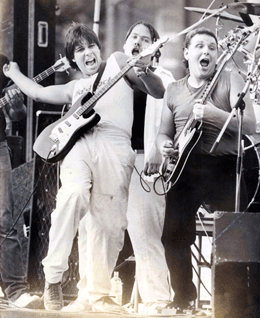 |
|
Tom Guerra (left) and Mark Easton in 1986 |
ME: I’ve thought about this, and I had thought it was the arrival of the Beatles. But, as my mom recently reminded me, I was playing toy guitars as far back as Elvis’s first hits! I had always sung along with the radio, and been in choirs in school. I dabbled with the guitar a little before, but when my dad passed away when I was 11-years-old, mom bought me my first acoustic for Christmas. It was a $20 Woolworth special! The next year, I traded up for my first electric, a Saturn! I stopped playing for about six months before the Beatles released “Hey Jude/Revolution”, then I picked it up again and never looked back!
Who were some of your early influences?
ME: Elvis, Trini Lopez, Andre Segovia, the Beatles, and then B.B. King and Johnny Winter, shortly followed by Eric Clapton, Jimmy Page, Jeff Beck, and of course, my personal all time fave, Jimi Hendrix. After them, there are just way too many to remember!
There’s a New England urban legend about you playing the “Star Spangled Banner” during a school talent show.
ME: In 1971, my senior year, we had our class talent show, Class Night, as every class had. I put the band together, borrowed most of the gear, and was band leader, so I got to choose the tunes and whip the band into shape. I opened the show with Hendrix’s version, or as close as I could get, not out of rebellion or disrespect, but exercising my right to perform and sound the way I wanted. Most of the parents there made their kids sit down, and I got called into the vice principal’s office the following Monday.
Do you remember your first good guitar and amp setup?
ME: Les Paul Deluxe and Ampeg V4 full stack! I traded the Saturn for a Harmony 335 knockoff, then a Hagstrom, and then a Les Paul copy (which was what I played the “Star Spangled Banner” with), and finally the Les Paul Deluxe in 1972. I traded the Paul for an all maple Strat. When that burned in a fire in the equipment van, I got a bank loan and bought a 1971 Gibson Les Paul Black Beauty Fretless Wonder, the finest guitar I have ever played! After owning that for about a year, it fell out of the trailer when our roadie forgot to latch the doors, and was run over, and the headstock was snapped in half. I was told in wasn’t repairable, so I took the bridge and one of the pickups, and gave the rest to John Clark of the Bailey Brothers Band [from Boston, MA].
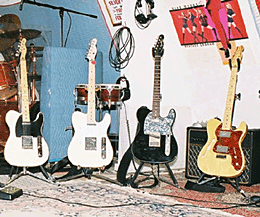 |
|
The Four Ladies |
I then took the Strat body and electronics, which were charred from the van fire, and the only usable pieces left, filled the tremolo cavity with wood putty, put the Gibson bridge and one humbucker in the center position, found a new neck, and built the Frankenstein Strat which I played until I joined Avalanche. Just before joining that group I purchased a 1977 Les Paul Standard, which was not a very good one. I traded that for a 1962 Gibson Explorer and traded that for a The Paul, which I played until Avalanche’s demise.
I went through many other guitars which didn’t make me happy, including an Ibanez Destroyer, a Kramer single humbucker, a Charvel Van Halen knockoff, a Carvin double-neck, and finally, in the Perfect Stranger [band], my first Tele. I bought one more Les Paul Custom, a magenta Anniversary issue with EMG pickups, which I sold at the start of King Cod and the Blues Sharks, and bought a Strat Plus, one of the first with the Lace Sensors in it. I then got a Cort Tele from my family for my 45th birthday. I completely re-built this guitar, with Fender Texas Special pickups, Graphtech Stringsaver saddles and nut, and Schaller pegs. I gave the Strat to my daughter Christina, bought another Cort, the sister to the one I have, gave that to my son Matt, and got a Schecter Strat-style guitar.
I also finally got a couple of nice acoustics. I had a Yamaha for a few years in the ’70s, and didn’t get another acoustic until 2001 when I got my Martin D-16, and later a Samick parlor sized acoustic, which I use mostly for slide.
For amps, I’ve used just about everything, Marshalls, Fenders, Voxes, Ampegs, some tube, some solid state. I’ve never really had a problem getting something usable from any amp, as long as I had the right axe.
Avalanche was one of those regional bands that always seemed to be on the verge of breaking big, you had a big single and there were a lot of high hopes for that group, which also featured your brother Barry on drums, Mike Foster on guitar and legendary bassist Charles Calmese (Muddy Waters, Ike Turner, James Cotton, and Johnny Winter). I remember seeing you guys with stacks of Marshalls and all the best equipment, and you sounded huge.. You guys opened for AC/DC on their first U.S. tour, right? Any memories of that?
ME: This was AC/DC’s first American tour; I believe their third gig in the states. Malcolm and Angus were using two Marshall 100W Plexis with 4 4×12″ Cabs with Celestions. Our Marshalls were re-built by Dennis Electronics in New York City, with all military grade components, making them much more dependable and road worthy, as well as adding some serious balls to them. Also, all the Celestions in our cabs were replaced with Altec Lansings. This gave our amps a sound quality all their own. They were much cleaner, ballsier, and heavy! As a result, we were louder than AC/DC!
Angus also used the very first wireless transmitter we ever heard. He started playing upstairs in the dressing room, and then hit the stage after the rest of the band was up!
What ultimately happened with Avalanche?
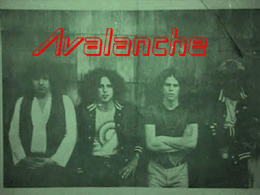 |
|
Avalanche |
ME: The entire history of the band can be read by accessing Michael Foster’s journal. We were about to be signed when, through a combination of sabotage by some very jealous people, Charles and Michael had a falling out. Also, it was the ’70s, and we all tended to overindulge! So, in early 1980 I entered rehab and that was basically the end of it, at least for Barry and me. Michael continued to record and perform Avalanche music with other musicians. Barry and I went on to form Perfect Stranger with Tom “T-Bone” Guerra on second guitar, and later King Cod and the Blues Sharks.
You actually lived at The Shaboo, a legendary music club in Willimantic, Connecticut, that regularly featured acts ranging from Muddy Waters to The Police, and just about everyone in between. Did you see a lot of shows there as well? What were some of your favorites?
ME: I saw so many great shows there that it would be impossible to remember them all! The ones that stand out for me are James Montgomery, Manfred Mann’s Earth Band, the loudest band I’ve ever seen to this day, the Police, who played for 50 people, and I thought they were roadies when they arrived, AC/DC, Freddie King, Buddy Rich, Dire Straits, Hound Dog Taylor, Muddy Waters, and of course James Cotton.
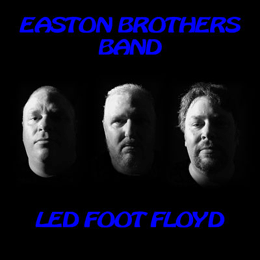 |
|
Led Foot Floyd |
I was there for the recording of “Live” and” On the Move” by Cotton. I watched Aerosmith rehearse “Dream On” before it was recorded. I jammed with Philip Guy [Buddy Guy’s brother], who bought my Fender Super Reverb for $100 after Junior Wells puked on it! Buddy Guy, B.B King, Cheap Trick, Rick Derringer, Johnny Winter, the Chambers Brothers, Lester is a sweetheart(!), Count Basie, Miles Davis. I experienced an overload of fantastic talent!
You’ve toured all over the U.S. with some big names. Tell us about some of your favorite experiences.
ME: Opening for Stevie Wonder in 1974 was certainly a highlight. In 1998, the Shaboo All-Stars opened for B.B. King, which was also great. Opening for and meeting Muddy Waters, and the Chambers Bros. as well as opening for Leon Russell on Ken Johnson’s last tour will also stick with me.
Besides being a great guitarist, you’re recognized as a very talented writer and singer, too and have released several self-produced CDs. What are some of the tunes that you’re happiest with, and where can our readers check out your music?
ME: I am really happy with “Medicine Man” from our 1994 CD, Wait for the Medicine Man, from a writing point of view.
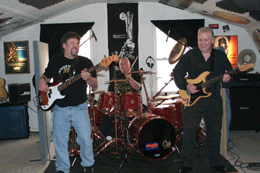 |
|
Easton Brothers Band |
I think our next CD, Highway Hallucinations Part 2 has a little more diverse collection of tunes than anything I’ve ever done. My brother, Barry, played drums, and I did all the rest of the instruments and vocals, except for the piano on a tune called “It’s True”. Again, from a writing point of view, I especially like the ballad “It’s True”, including the guitar work as well, because it’s a direct Beatles influence. But, the song “Alright” is my favorite, because of the guitar work.
Production wise, our new CD, Led Foot Floyd is, in my opinion, the best produced CD I’ve ever done. I’m really proud of the band’s input with the arrangements. If I had to pick one song for what I think is decent guitar work, I would choose “Shotgun Pete”.
I also did an instrumental called “Thundersky” with a drum machine, and played the rest of the instruments, recorded on a Zoom MRS4 4-track. That recorder was my introduction to digital recording and computers. I got the machine and started learning the computer in 2001 when I was recovering from heart surgery. At that time, I could barely send an email. I spent the next year learning. “Thundersky” has one of the best solos I ever got to record, again in my opinion. I’m sure I’ve done many others on that level live, but alas I don’t get to record many live performances.
All these tunes can be heard at Indie Hits, and Song Planet. Our main site is at Easton Brothers. Please remember to sign our guestbook!
Your blues band Sweet Daddy Cool Breeze was just named Best Blues Band in a recent New England Valley Advocate poll, and you’ve traveled extensively with them. What can you tell us about that group?
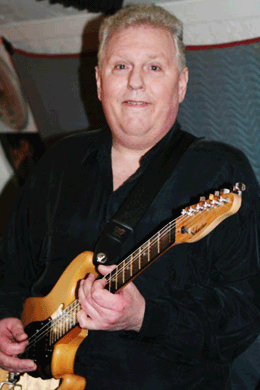 |
|
Mark Easton |
ME: In early 1986, I received a phone call from Ken Johnson [James Cotton, Steve Miller], asking if I could play a blues jam with him in Northampton MA, at a club called Sheehan’s for $50.00. It was here that I met the partner that I’ve been working with for the last 20 years, Wally “Sweet Daddy” Greaney. I asked Wally to come and jam with a group I was just forming, which became King Cod and the Blues Sharks. Wally and I continued to do side gigs with the Valley Blues Band with Ken Johnson and jazz bassist Joe Fonda, and then a string of various drummers and bass players.
The band became Sweet Daddy Cool Breeze, and we settled on the present lineup, with Eddy Humber on bass and Jimmy Mac McNamara on drums. The thing about Sweet Daddy in those early days was that it was Wally’s and my fun gig, which never rehearsed, and never really did anything the same way twice. It wasn’t until we started to record that we had to tighten things up. This was our traditional gig, to recharge our musical batteries and just enjoy what we did.
We’ve since recorded four CDs, Live in France being the only one I didn’t play on because I was unable to travel to Europe at the time. We’ve also been fortunate enough to do several East Coast tours, and continue to do shows whenever and wherever we can.
Do you have any plans for going out on tour with Sweet Daddy any time soon?
ME: We will be hitting the road for our annual winter tour south later this month. We should be going to Illinois, Kentucky, Pennsylvania, Delaware, North Carolina, and Florida all the way to Key West!
I understand that you’re doing some gigs with [Allman Brothers’ drummer] Jaimoe.
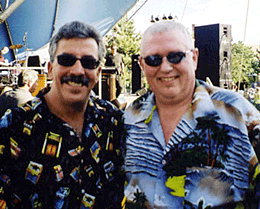 |
|
Wally Greany and Mark Easton |
ME: I’ve been blessed with being able to do a few gigs with one of the greatest drummers and absolute gentlemen I’ve ever met or jammed with! Sweet Daddy and I will be doing a couple private parties with Jaimoe and Joe Fonda. We’re hoping that Jaimoe can find time in his very busy schedule to do some club dates.
Your brother Barry is an incredible drummer, and you’ve played together for years. Did you guys always do that growing up, and do you think that being brothers gives you a sort of ESP that only brothers can have?
ME: Barry and I jammed together as kids, but the first band we were in together was when he came in to replace Gene Melendreras, who had left to join Dominic Troiano, in Buster Browne. This group did a lot of touring in the Northeast and Southeast Canada between 1975 and ’77, roughly. The next group was Avalanche!
You two also have a studio called Roughcut Studios. What studio projects are you currently involved with?
ME: We’re getting ready to record the next Sweet Daddy CD, as well as doing some rap demos, some tunes for Tom Sanders and the Known Unknowns [formerly the Patriot Act], as well as the next Easton Brothers project.
As far as your current live setup, what are you primarily playing these days?
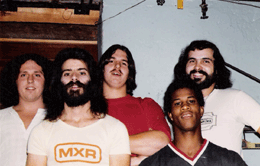 |
|
Mark Easton (far left) with the Buster Browne Band |
ME: I really like Peavey amps. I had a Delta Blues, which finally succumbed to road wear, and died. I recently purchased a Peavey Valve King 212 combo, which has to be one of the nicest sounding amps I’ve ever owned! For rock gigs I use my Schecter with Semour Duncan pickups and a Wilkison tremolo, and my Cort Tele with Texas Specials for slide. For blues gigs I use the Cort Tele. For pedals I use a Danelectro Dan Echo for echoes and slaps, a tweaked Dunlap Cry Baby Wah, and an Expandora distortion. I’m also trying a Danelectro Rocky Road rotary speaker pedal for modulation. In the studio, I use whatever gets the tone I need. I am finally satisfied with my tone!
Do you use any open tunings?
ME: I use mostly standard, but use open G or A (G capoed up a full step) for slide, along with open E, D, and DADGAD, usually for jump starting new ideas if I get stuck with standard.
Who are your all-time favorite musicians, and are there any current players you are listening to these days?
 |
|
Mark Easton |
ME: Tom, I like so many it would be impossible to name them all. The Beatles, and just about every first wave British invasion band, many of the Chicago, Texas, and Delta blues artists. If I had to choose one guitar player that has and still does blow me away every time I listen to him it’s got to be Jimi Hendrix, at least for rock! For blues, it has to be Muddy Waters!
I don’t really care for a lot of the newer music, but I am impressed and intrigued by Radiohead, Tool, Train, and I still think U2 is one of the greatest bands on the planet!
Mark, as always it’s been a pleasure. Best wishes with all of the projects and congratulations on winning the Advocate poll.
ME: Thank you very much, and the pleasure was mine!